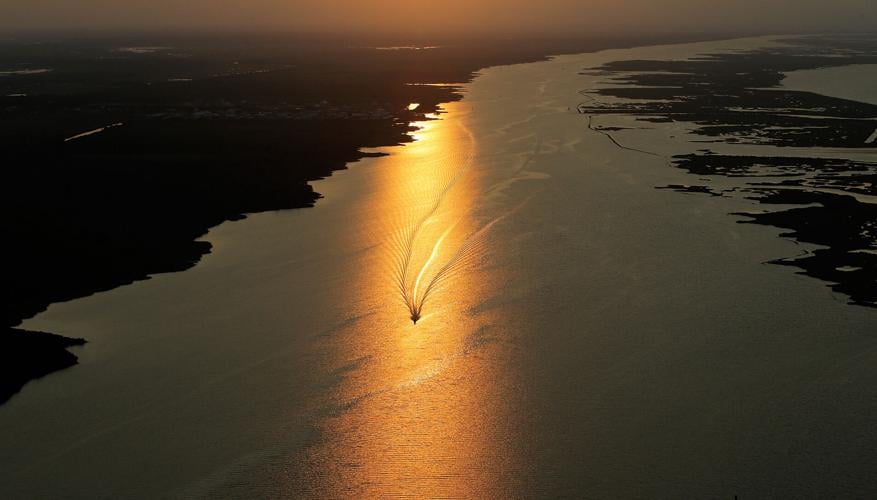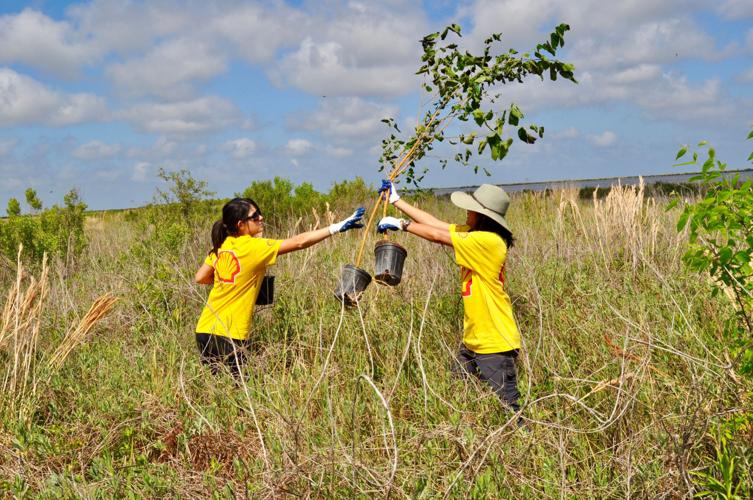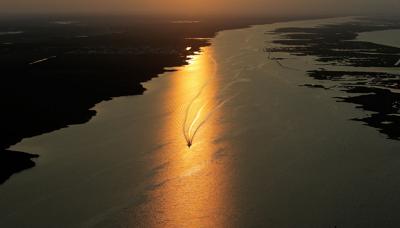Louisiana’s ambitious and expensive plans for restoring the coast received strong backing from five of the candidates vying to be the state’s next governor.
At a forum hosted by the Coalition to Restore Coastal Louisiana in New Orleans on Friday, the candidates laid out a nearly identical vision for protecting and restoring the state’s endangered coast.
Louisiana Treasurer John Schroder and Attorney General Jeff Landry, both high-profile Republicans, skipped the event.
Earning plaudits from most of the candidates was the state’s 50-year, $50 billion coastal master plan and its latest update, which received unanimous support from the state Legislature last month. The plan calls for new large-scale levee projects and other hurricane barriers, as well as vast marsh and barrier island rebuilds.

Mark Gagliano of Coastal Environments uses a crane to lift gabion cages full of recycled oyster shells into Barataria Bay in August 2020. The shells were used to build a reef that will improve habitat and slow coastal erosion. (Photo by Tristan Baurick, The Times-Picayune | The New Orleans Advocate)
The plan garnered widespread bipartisan support — a rarity for the the Louisiana Legislature, said Rep. Richard Nelson, a Republican from Mandeville and a candidate for governor.
“In the Legislature, we fight about a lot of things that aren’t that critical,” he said. “And yet we have the master plan come up, and it’s $50 billion … and we all get behind it.”
Working to ease a land-loss rate that robs the state of a football field-worth of land every 100 minutes should be a priority for every Louisiana lawmaker, said Shawn Wilson, the only major Democrat running and the former secretary of the state Department of Transportation and Development.
“The coast is important not just to people who live there, but the entire state,” he said, noting its value for shipping, seafood and energy production. “It is the also the first line of defense. It gets the battering ram every time there’s a hurricane or a storm.”

Volunteers plant trees on a restored coastal ridge near Port Fourchon in April 2017.
The other candidates at the forum, which was part of the State of the Coast conference, were Stephen Waguespack, the Republican former head of the Louisiana Association of Business and Industry; state Sen. Sharon Hewitt, a Republican and former Shell executive from Slidell; and Hunter Lundy, a Lake Charles attorney who is running as a political independent.
The seven candidates hope to replace Gov. John Bel Edwards, a Democrat who is term limited.
The five candidates expressed support for one of the coastal plan’s most expensive and controversial projects: the Mid-Barataria Sediment Diversion. The $3 billion project would funnel mud-laden Mississippi River water through a section of levee in Plaquemines Parish and send it into Barataria Bay, potentially reviving 21 square miles of marsh over 50 years.

Map of the Mid-Barataria sediment diversion project.
The candidates acknowledged the diversion would harm oyster-growing operations and the shrimping industry, but agreed the project has more upsides than downsides.
“We are going to make sure it will be data driven and we will change and mitigate the negative impacts as much as possible,” Hewitt said.
Lundy said the diversion and other expensive restoration projects need more oversight.
“We need to track every dollar,” he said. “Contracts need to be disclosed to the public. Audits need to be done. There’s not going to be any sneaking around or brother-in-law deals.”

A Coalition to Restore Coastal Louisiana volunteer helps build an oyster shell reef alongside a centuries-old Native American settlement site in Plaquemines Parish in July 2021.
Maintaining funding for coastal projects is a looming challenge, the candidates agreed. Restoration and protection efforts have depended on the $10 billion settlements with BP over the 2010 Deepwater Horizon oil disaster. Those funds are expected to run out in less than 10 years.
“We have another test around the corner,” Waguespack said. “We need new revenue streams to keep the line going past 2031.”
He and other candidates back efforts that would give Louisiana a larger share of federal oil and gas revenues. Waguespack also called for a cut of the money made from nascent industries taking shape along the Gulf Coast, including offshore wind farms and carbon capture and sequestration enterprises.

Wetlands south of New Orleans, crisscrossed by canals, are seen during a flyover of coastal Louisiana on May 18, 2018.
Hewitt and Lundy differed on how much the state should penalize the oil and gas industry for coastal damages.
“You need a viable oil and gas industry if you want to rebuild the coast,” Hewitt said. “You don’t need an administration that is declaring war on the oil and gas industry …”
Lundy noted that the many canals the industry carved into the coast are exacerbating erosion. These, he said, should be filled in at the industry’s expense.
“We have thousands of wide open canals that have allowed saltwater intrusion into our marshes,” he said. “Why aren’t we enforcing it? Mobil, Chevron and Shell (caused) billions of dollars of damage to us. We need to get them to comply with the law and get them to fix it.”
Failing to carry out the plan could cost the state about 1,100 square miles of land – more than half the size of Rhode Island – over the next 50 years.
When Ben Malbrough began working to improve Bayou Lafourche 10 years ago, the once-scenic waterway was little more than an emaciated trickle. …
Two Superdomes worth of Mississippi River sediment has created nearly 1,700 acres of freshly formed land.










